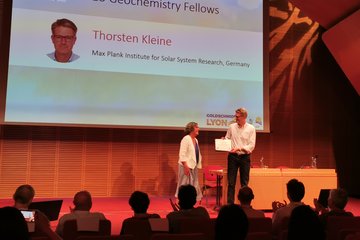Alle Typen
1.
Zeitschriftenartikel
Determination of the SO/PHI-HRT wavefront degradation using multiple defocused images. Astronomy and Astrophysics 681, S. A58 (2024)
2.
Zeitschriftenartikel
Determination of the SO/PHI-HRT wavefront degradation using multiple defocused images. Astronomy and Astrophysics 681, S. A58 (2024)
3.
Zeitschriftenartikel
The Sun's differential rotation is controlled by high-latitude baroclinically unstable inertial modes. Science Advances 10, S. eadk5643 (2024)
4.
Zeitschriftenartikel
The Sun's differential rotation is controlled by high-latitude baroclinically unstable inertial modes. Science Advances 10, S. eadk5643 (2024)
5.
Zeitschriftenartikel
Solar convective velocities: Updated helioseismic constraints. Physics of Fluids 36, S. 117136 (2024)
6.
Zeitschriftenartikel
The mean solar butterfly diagram and poloidal field generation rate at the surface of the Sun. Astronomy and Astrophysics 691, S. A9 (2024)
7.
Zeitschriftenartikel
Learned infinite elements for helioseismology: Learning transparent boundary conditions for the solar atmosphere. Astronomy and Astrophysics 690, S. A86 (2024)
8.
Zeitschriftenartikel
Sausage, kink, and fluting magnetohydrodynamic wave modes identified in solar magnetic pores by Solar Orbiter/PHI. Astronomy and Astrophysics 688, S. A2 (2024)
9.
Zeitschriftenartikel
Magnetic origin of the discrepancy between stellar limb-darkening models and observations. Nature Astronomy (2024)
10.
Zeitschriftenartikel
Magnetic origin of the discrepancy between stellar limb-darkening models and observations. Nature Astronomy 8, S. 929 - 937 (2024)
11.
Zeitschriftenartikel
A first rapid synoptic magnetic field map using SDO/HMI and SO/PHI data. Astronomy and Astrophysics 681, S. A59 (2024)
12.
Zeitschriftenartikel
A first rapid synoptic magnetic field map using SDO/HMI and SO/PHI data. Astronomy and Astrophysics 681, S. A59 (2024)
13.
Zeitschriftenartikel
Entropy-calibrated stellar modeling: Testing and improving the use of prescriptions for the entropy of adiabatic convection. Astronomy and Astrophysics 687, S. A146 (2024)
14.
Zeitschriftenartikel
Comparison of magnetic data products from Solar Orbiter SO/PHI-FDT and SDO/HMI. Astronomy and Astrophysics 685, S. A28 (2024)
15.
Zeitschriftenartikel
Quantitative passive imaging by iterative holography: the example of helioseismic holography. Inverse Problems 40, S. 045016 (2024)
16.
Zeitschriftenartikel
Quantitative passive imaging by iterative holography: the example of helioseismic holography. Inverse Problems 40, S. 045016 (2024)
17.
Zeitschriftenartikel
Assembling algorithm for Green's tensors and absorbing boundary conditions for Galbrun's equation in radial symmetry. Journal of Computational Physics 519, S. 113444 (2024)
18.
Zeitschriftenartikel
A flux-independent increase in outflows prior to the emergence of active regions on the Sun. Monthly Notices of the Royal Astronomical Society 533, S. 225 - 243 (2024)
19.
Zeitschriftenartikel
Transition of the Sun to a Regime of High Activity: Implications for the Earth Climate and Role of Atmospheric Chemistry. JOURNAL OF GEOPHYSICAL RESEARCH-ATMOSPHERES (15) (2024)
20.
Zeitschriftenartikel
Detecting stellar activity cycles in p-mode travel times. Proof of concept using SOHO/VIRGO solar observations. Astronomy and Astrophysics 682, S. A142 (2024)











